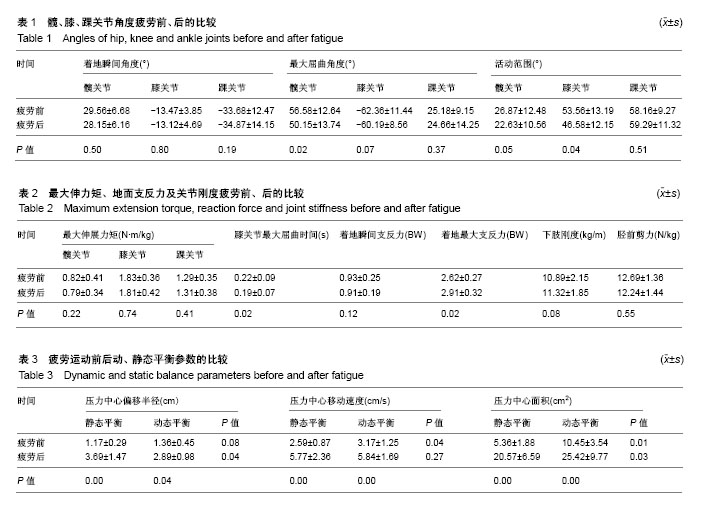| [1] Chang et al. Acute Garcinia mangostana (mangosteen) supplementation does not alleviate physical fatigue during exercise: a randomized, double-blind, placebo-controlled, crossover trial. J Int Soc Sports Nutr.2016;25(6):13-20.[2] Liederbach M, Hagins M, Gamboa JM et al. Assessing and reporting dancer capacities, risk factors, and injuries: recommendations from the IADMS standard measures consensus initiative. J Dance Med Sci.2012;16(4): 139-153.[3] Troy KL, Grabiner MD. Asymmetrical ground impact of the hands after at rip-induced fall: Experimental kinematics and kinetics. Clin Biomech (Bristol, Avon).2007;22:1088-1095.[4] Brown C, Bowser B, Simpson KJ. Movement variability during single leg jump landings in individuals with and without chronic ankle instability. Clin Biomech (Bristol, Avon).2012; 27:52-63.[5] Schmitz RJ, Kulas AS, Perrin DH, et al. Sex differences in lower extremity biomechanics during single leg landings. Clin Biomech (Bristol, Avon). 2007;22 (6): 681-688.[6] Julie A, Riann MP, Randall D, et al. Descriptive epidemiology of collegiate women’s volleyball injuries: National collegiate athletic association injury surveillance system, 1988-1989 through 2003-2004. J Athl Train.2007;42(2): 295-302.[7] FinstererJ. Biomarkers of peripheral muscle fatigue during exercise. BMC Musculoskelet Disord.2012;13(1):218.[8] Wikstrom EA, Powers ME, Tillman MD. Dynamic stabilization time after isokinetic and functional fatigue. J Athl Train. 2004; 39(3): 247-253.[9] Price RJ, Hawkins RD, Hulse MA, et al. The Football Association medical research programme: An audit of injuries in academy youth football. Br J Sports Med. 2004;38 (4): 466-471.[10] Kellis E, Kouvelioti V. Agonist versus antagonist muscle fatigue effects on thigh muscle activity and vertical ground reaction during drop landing. J Electromyogr Kinesiol. 2009; 19 (1): 55-64.[11] Padua DA, Arnold BL, Perrin DH, et al. Fatigue, vertical leg stiffness, and stiffness control strategies in males and females. J Athl Train. 2006;41 (3): 294-304.[12] Coventry E, O'Connor KM, Hart BA, et al. The effect of lower extremity fatigue on shock attenuation during single -leg landing. Clin Biomech (Bristol, Avon).2006;21(10): 1090-1097.[13] Madigan ML, Pidcoe PE. Changes in landing biomechanics during a fatiguing landing activity. J Electromyogr Kinesiol. 2003;13 (5): 491-498.[14] Urabe Y, Kobayashi R, Sumida S, et al. Electromyographic analysis of the knee during jump landing in male and female athletes. Knee.2005;12 (2): 129-134.[15] Luke S. Hopper, Jacqueline A. Alderson, Bruce C. Elliott, Timothy R. Ackland. Dance ?oor force reduction in?uences ankle loads in dancers during drop. J Sci Med Sport.2014; 22(2):55-61.[16] Batatinha HA, da Costa CE, de França E, et al. Carbohydrate use and reduction in number of balance beam falls: implications for mental and physical fatigue. J Int Soc Sports Nutr. 2013; 10(2): 32-38.[17] Brown TN, McLean SG, Palmieri-Smith RM. Associations between lower limb muscle activation strategies and resultant multi-planar knee kinetics during single leg landings. J Sci Med Sport.2014;17: 408-413.[18] [18] Donnelly CJ, Elliott BC, Doyle TLA, et al. Changes in muscle activation following balance and technique training and a season of Australian football. J Sci Med Sport. 2014; 12(4):1026-1031.[19] Milanez VF, Spiguel Lima MC, Gobatto CA, at al. Correlates of session-rate of perceived exertion (RPE) in a karate training session. J Sports Sci Med. 2011;26:38-43.[20] Self BP, Paine D. Ankle biomechanis during four landing techniques. Med Sci Sports Exerc.2001;33(8): 1338-1344.[21] Chappell JD, Herman DC, Knight BS, et al. Effect of fatigue on knee kinetics and kinematics in stop -jump tasks. Am J Sports Med.2005;33 (7):1022-1029.[22] Farley CT, Houdijk HH, Van Strien C, et al. Mechanism of leg stiffness adjustment for hopping on surfaces of different stiffnesses. J Appl Physiol (1985).1998; 85 (3):1044-1055.[23] 成戎珠,苏芳庆,林纯彬等.利用不同的力板参数侦测单侧脚踝扭伤患者的姿势控制[J].中华物疗志,1997,22(4):251-259.[24] Struminger AH, Lewek MD, Goto S, et al. Comparison of gluteal and hamstring activation during ?ve commonly used plyometric exercises. Clin Biomech (Bristol, Avon).2013;28: 783-789.[25] Lee SP, Powers C. Fatigue of the hip abductors results in increased medial–lateral center of pressure excursion and altered peroneus longus activation during a unipedal landing task. Clin Biomech (Bristol, Avon).2013;28:524-529.[26] Lafortune MA, Lake MJ, Hennig EM. Differential shock transmission response of the human body to impact severity and lower limb posture. J Biomech.1996;29 (12):1531 -1537.[27] Derrick TR, Dereu D, McLean SP. Impacts and kinematic adjustments during an exhaustive run. Med Sci Sports Exerc. 2002;34 (6):998 -1002.[28] Lyle MA, Valero-Cuevasa FJ, Gregor RJ, et al. Control of dynamic foot-ground interactions in male and females occer athletes: Females exhibit reduced dexterity and higher limb stiffness during landing. J Biomech. 2014;47:512-517.[29] McNair PJ, Marshall RN. Landing characteristics in subjects with normal and anterior cruciate ligament deficient knee joints. Arch Phys Med Rehabil. 1994;75 (5):584-589.[30] Wikstrom EA, Powers ME, Tillman MD. Dynamic stabilization time after isokinetic and functional fatigue. J Athl Train.2004; 39(3): 247-253.[31] Bruton MR, O’Dwyer N, Adams R. Sex differences in the kinematics and neuromuscular control of landing: Biological, environmental and sociocultural factors. J Electromyogr Kinesiol.2013;23:747-758.[32] Potthast W, Bruggemann GP, Lundberg A, et al. The in?uence sofimpact interface, muscle activity, and knee angle on impact forces and tibial and femoral accelerations occurring after external impacts. J Appl Biomech.2010;26:1-9.[33] Gibson W, Campbell A, Allison G. No evidence hip joint angle modulates intrinsically produced stretchre?ex in human hopping. Gait Posture. 2013;38:1005-1009.[34] Forestier N, Teasdale N, Nougier V. Alteration of the position sense at the ankle induced by muscular fatigue in humans. Med Sci Sports Exerc. 2002;34(1):117-122.[35] Gribble PA, Hertel J, Denegar CR, et al. The effects of fatigue and chronic ankle instability on dynamic postural control. J Athl Train. 2004;39(4): 321-329.[36] Lepers R, Bigard AX, Diard JP, et al. Posture control after prolonged exercise. Eur J Appl Physiol Occup Physiol.1997; 76(1): 55-61.[37] Yaggie JA, McGregor SJ. Effects of isokinetic ankle fatigue on the maintenance of balance and postural limits. Arch Phys Med Rehabil. 2002;83(2): 224-228. |
.jpg)

.jpg)
.jpg)